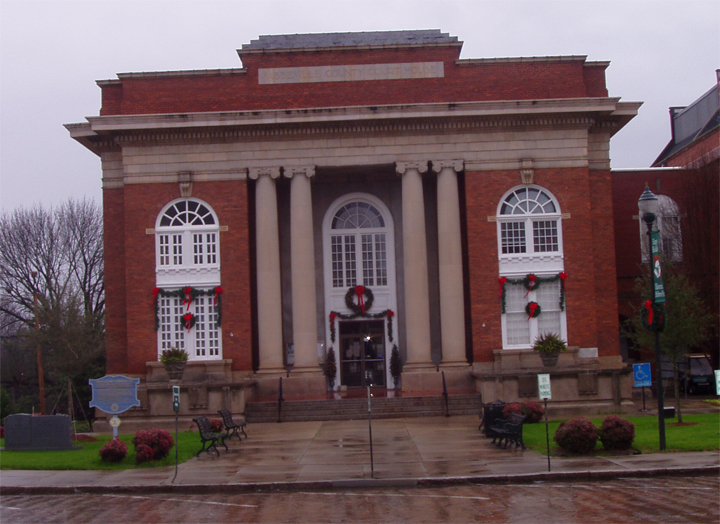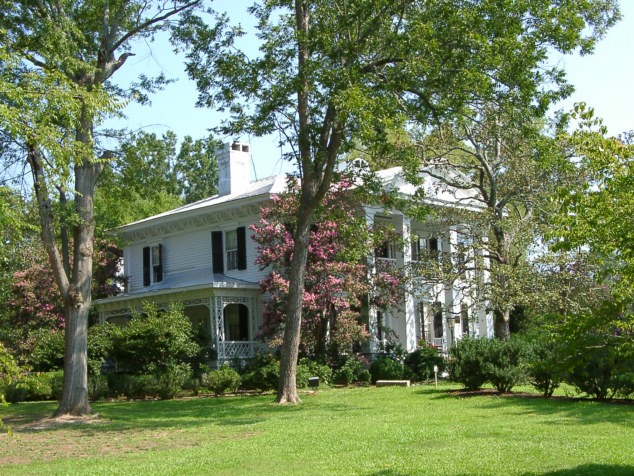 |
||||
|
|
||||
 Abbeville County Court House - Abbeville, SC (2008) A town that boasts of being both cradle and deathbed of the Confederacy is a town that is not going to change much. Yet the legacy of Abbeville, South Carolina springs more from preservation of its town square than its status as a peculiar footnote in history. It has always been the county seat of Abbeville County. The town's special appeal comes from the thriving commercial and cultural community that grew up around the town square during an interlude of prosperity from about 1880 to 1910. The square, which has been frozen in time, draws tourists despite the fact that it's in the upstate farmland, an hour-long two-lane drive from Greenville, Columbia, or Augusta. Visitors experience a mixture of Old South courtliness, European heritage, and American nostalgia. Abbeville was founded in 1785 in an area settled some thirty years earlier by French Huguenots, one of whom named the place after a town with the same name in France. The European heritage manifests itself most in Trinity Episcopal Church, which underwent construction in 1859. The pink stone Gothic revival structure is a block from the town square and is one of twenty churches in the 5,237-population (2010) community. Among the region's first settlers was Patrick Calhoun, father of John C. Calhoun, one of South Carolina's favorite sons and U.S. Vice-President. From 1807 to 1817, the younger Calhoun had his law office on Abbeville's town square, near where the county court house stands today. Other Whitehouse ties to Abbeville: Post Civil War President Andrew Johnson had a tailor shop just off of town square. Robert Mills, the noted architect who designed several Washington DC buildings and the Washington Monument, lived for a time in Abbeville. The Abbeville County Jail, built in 1854 and designed in Mill's style, now houses the Abbeville County Museum, which displays local artifacts and memorabilia. It is open Sunday and Wednesday afternoons, 3-5 p.m., and by appointment. But the connection Abbeville takes greatest pride in is Jefferson Davis, President of the Confederacy. The town's claim to being the Confederacy's cradle and deathbed is no idle boast. On November 22, 1860, a meeting to launch South Carolina's secession from the Union took place in Abbeville; one month later South Carolina became the first state to secede. That the Confederacy died in Abbeville is by mere happenstance. After Richmond fell in April of 1865, President Jefferson Davis and his government fled south, stopping along the way at the Abbeville mansion of his friend Armistead Burt. On May 2, 1865, in the front parlor, Davis reluctantly agreed to give up the fight and dissolve the Confederate government.  Burt-Stark Mansion - Abbeville, South Carolina Armistead Burt's home, now the Burt-Stark Mansion, was built in the 1830s by David Lesley, an Abbeville lawyer and planter who, according to local lore, wanted to give his Northern-born wife a replica of a Hudson Valley house she admired. Legend further holds that he sent Cubic, a slave and master carpenter, to New York to study the house. Over the next ten years Cubic is said to have built the Abbeville Mansion with the help of skilled artisans and craftsmen, probably all of whom were slaves. Burt bought the house in 1862, but, impoverished by the war and its aftermath, and because his wife's health was failing, sold the property and all its furnishings in 1868. In 1900, the house was purchased by James Samuel Stark. In 1971, his daughter, Mary Stark Davis, gave the house, and later the contents, to the Abbeville County Historical Preservation Commission. Before her death in 1987 at age 102, she admonished the trustees that "on judgement day" she would return through the front door and "you better not have moved anything." The now-public property is therefore not just a museum, but a home with clothes hung on a screen in Mary Stark Davis' bedroom and slippers placed by her rocking chair. Two pieces of furniture have particular historical value: Armistead Burk's desk in the upstairs living room and, in the front upstairs bedroom, a bed Jefferson Davis slept in. The Burt-Stark Mansion, open to visitors on Friday and Saturday afternoons or by appointment, and is one of the many grand Southern homes lining Main Street, Greenville Street, and other downtown neighborhoods. Several private homes are open to tours during the gala Holiday Open House and again during Abbeville's Annual Spring Festival. After the American Civil War, Abbeville County was sustained by a diversified agricultural system. Then the railroad brought a spurt of prosperity beginning in about 1890. Abbeville was an overnight stop on the New York - Atlanta route, and capitalized on that role - including an Opera House in its new municipal building in 1908. The Opera House was later transformed into a movie theater, then gradually deteriorated. In 1968, a local effort restored the 350-seat Opera House to its former glory, and once again it presents shows virtually year round.  Abbeville Opera House (2008) Across the street is the hotel that opened in 1902 as the Eureka. The touring companies stayed there, as did vacationers and traveling salesmen. The hotel, closed in 1972, was remodeled and reopened as the Belmont Inn in 1984. The original wood floors and doors and replica antique furniture recapture some of the Eureka's turn of the century atmosphere. That corner of the town square evokes Abbeville's southern-gentry past, but the rest - meticulously manicured and adorned with flower planters - is like a Norman Rockwell painting. Storefronts have been restored to their early twentieth century appearance. D. Poliakoff opened in 1900 and still sells clothes from wood cabinets and counters originally installed in its present location. A couple of doors down is the Rough House, a pool hall little changed since it opened in 1936; it has its original Brunswick drop-pocket pool tables, seats from the old Opera House, and advertising memorabilia, pictures, and posters. Across the square and lining Trinity Street down to the church, period storefronts are home to antique shops. That Mary Stark Davis insisted her mansion remain a home rather than a museum is in perfect keeping with the whole of Abbeville's charm. The residents, instead of buying something new to call their own, have preserved what they owned all along. As Abbeville Court House, the town was granted a U.S. Post Office on July 1, 1795, and its first Postmaster was Mr. John Bowie. On January 15, 1895, the Post Office Department officially changed its name simply to Abbeville. It has been in continuous operation ever since inception. Click Here to view / download a 2017 map of Abbeville, SC. Adobe PDF file. Fairly large. |
 |
 |
© 2019 - J.D. Lewis - PO Box 1188 - Little River, SC 29566 - All Rights Reserved